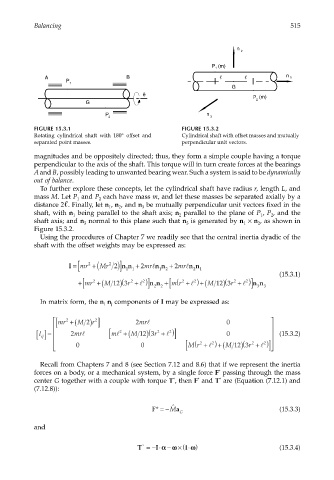Page 534 - Dynamics of Mechanical Systems
P. 534
0593_C15_fm Page 515 Tuesday, May 7, 2002 7:05 AM
Balancing 515
n
2
P (m)
1
A B n 1
P
1
G
ê
P (m)
G 2
P n
2 3
FIGURE 15.3.1 FIGURE 15.3.2
Rotating cylindrical shaft with 180° offset and Cylindrical shaft with offset masses and mutually
separated point masses. perpendicular unit vectors.
magnitudes and be oppositely directed; thus, they form a simple couple having a torque
perpendicular to the axis of the shaft. This torque will in turn create forces at the bearings
A and B, possibly leading to unwanted bearing wear. Such a system is said to be dynamically
out of balance.
To further explore these concepts, let the cylindrical shaft have radius r, length L, and
mass M. Let P and P each have mass m, and let these masses be separated axially by a
2
1
distance 2 . Finally, let n , n , and n be mutually perpendicular unit vectors fixed in the
3
1
2
shaft, with n being parallel to the shaft axis; n parallel to the plane of P , P , and the
1
2
1
2
shaft axis; and n normal to this plane such that n is generated by n × n , as shown in
2
1
3
3
Figure 15.3.2.
Using the procedures of Chapter 7 we readily see that the central inertia dyadic of the
shaft with the offset weights may be expressed as:
2
n n + mrl
2
I =[ mr 2 +(Mr 2 )] 11 2 n n + mrl n n 1 (15.3.1)
2
2
1
(
(
2
2
2
l
l
[ m
l
+[ mr 2 +(M 12 ) r3 2 + ) ] nn + (r 2 + ) +(M 12 ) r3 2 + ) ] nn 3
2
2
3
In matrix form, the n n components of I may be expressed as:
j
i
[ mr +( M ) ] 2 mrl 0
2
2
r
2
(
ij []
I = 2 mrl m [ l 2 + M ( 12 ) 3 r + ) ] 0 (15.3.2)
2
2
l
[ ( (
2
2
2
2
12
l
l
0 0 Mr + ) +( M ) 3 r + ) ]
Recall from Chapters 7 and 8 (see Section 7.12 and 8.6) that if we represent the inertia
forces on a body, or a mechanical system, by a single force F passing through the mass
*
*
center G together with a couple with torque T , then F and T are (Equation (7.12.1) and
*
*
(7.12.8)):
ˆ
F* =−M a (15.3.3)
G
and
α
T =− ⋅ −αωω × ⋅ (ΙΙωω ) (15.3.4)
I
*

